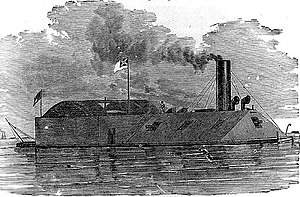 Contemporary engraving of the vessel. The accuracy of the image is not known.[1]
| |
| History | |
|---|---|
| Name | Baltic |
| Launched | 1860 |
| Commissioned | May 1862 |
| Decommissioned | July 1864 |
| Captured | May 10, 1865 |
| Fate | Sold, December 31, 1865 |
| General characteristics (post-conversion) | |
| Type | Casemate ironclad |
| Tonnage | 624 |
| Length | 186 ft (56.7 m) (o/a) |
| Beam | 38 ft (11.6 m) |
| Draft | 6 to 7 ft (1.8 to 2.1 m) |
| Installed power | 4 × horizontal return-flue boilers |
| Propulsion | 2 × steam engines |
| Speed | 5 knots (9.3 km/h; 5.8 mph) |
| Complement | 86 officers and men |
| Armament | 2 × Dahlgren guns, 2 × 32-pounders, 2 × smaller pieces |
| Armor | 2.5 in (64 mm) |
CSS[a] Baltic was an ironclad warship that served in the Confederate States Navy during the American Civil War. A towboat before the war, she was purchased by the state of Alabama in December 1861 for conversion into an ironclad. After being transferred to the Confederate Navy in May 1862 as an ironclad, she served on Mobile Bay off the Gulf of Mexico. Baltic's condition in Confederate service was such that naval historian William N. Still Jr. has described her as "a nondescript vessel in many ways".[3] Over the next two years, parts of the ship's wooden structure were affected by wood rot. Her armor was removed to be put onto the ironclad CSS Nashville in 1864. By that August, Baltic had been decommissioned. Near the end of the war, she was taken up the Tombigbee River, where she was captured by Union forces on May 10, 1865. An inspection of Baltic the next month found that her upper hull and deck were rotten and that her boilers were unsafe. She was sold on December 31, and was likely broken up in 1866.
- ^ Bisbee 2018, p. 56.
- ^ Silverstone 1989, p. xiii.
- ^ Still 1985, p. 80.
Cite error: There are <ref group=lower-alpha> tags or {{efn}} templates on this page, but the references will not show without a {{reflist|group=lower-alpha}} template or {{notelist}} template (see the help page).